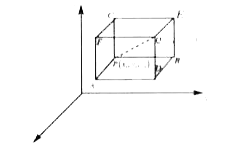A parallelopiped is formed by planes drawn through the points (1,2,3)and(9,8,5) parallel to the coordinate planes, then which of the following Is not length of an edge of this rectangular parallelopiped?Solution in Punjabi
2
4
6
8
The correct Answer is:(b)
Step by step video & image solution for A parallelopiped is formed by planes drawn through the points (1, 2, 3) and (9, 8, 5) parallel to the coordinate planes, then which of the following Is not length of an edge of this rectangular parallelopiped? by Maths experts to help you in doubts & scoring excellent marks in Class 12 exams.
Updated on:21/07/2023Topper's Solved these Questions
- THREE DIMENSIONAL COORDINATE SYSTEMBOOK - ARIHANT MATHSCHAPTER - THREE DIMENSIONAL COORDINATE SYSTEMEXERCISE - Exercise (More Than One Correct Option Type Questions)
28 Videos
- THREE DIMENSIONAL COORDINATE SYSTEMBOOK - ARIHANT MATHSCHAPTER - THREE DIMENSIONAL COORDINATE SYSTEMEXERCISE - Exercise (Statement I And Ii Type Questions)
14 Videos
- THREE DIMENSIONAL COORDINATE SYSTEMBOOK - ARIHANT MATHSCHAPTER - THREE DIMENSIONAL COORDINATE SYSTEMEXERCISE - Exercise For Session 4
7 Videos
- THEORY OF EQUATIONSBOOK - ARIHANT MATHSCHAPTER - THEORY OF EQUATIONSEXERCISE - Exercise (Questions Asked In Previous 13 Years Exam)
35 Videos
- TRIGONOMETRIC EQUATIONS AND INEQUATIONSBOOK - ARIHANT MATHSCHAPTER - TRIGONOMETRIC EQUATIONS AND INEQUATIONSEXERCISE - Exercise (Questions Asked In Previous 13 Years Exam)
12 Videos
Similar Questions
Given the equation of the line 3x−y+z+1=0and5x+y+3z=0. Then,which of the following is correct?
View Solutionlet →a=(ˆi+ˆj+ˆk) then find the unit vector along this vector
View SolutionFind the centre and radius of sphere 2(x−5)(x+1)+2(y+5)(y−1)+2(z−2)(z+2)=7.
View SolutionIn the quadratic equation ax2+bx+c=0. if δ=b2−4ac and α+β,α2+β2,α3+β3 are in G.P. and α,β are the roots of ax2+bx+c=0
View SolutionLet S={x∈(−π,π):x≠0,±π2}. The sum of all distinct solutions of the equation √2secx+cosecx+2(tanx−cotx)
=0 in the set S is equal to
View Solutionplanes are drawn parallel to coordinate planes through points (3,0,-1) and (-2,5,4). Find the length of the edges of parallelopiped so formed.
View SolutionPlanes are drawn through points (1,−3,4)and(4,7,−2) parallel to coordinate planes. Find the lengths of the edges of the rectangular parallelopiped so formed.
View SolutionPlanes are drawn parallel to the coordinates planes through the points (3,0,−1)and(−2,5,4). Find the lengths of the edges of the parallelopiped so formed.
View SolutionIf a parallelopiped is formed by planes drawn through the points (5,8,10) and (3,6,8) parallel to the coordinate planes, then the length of diagonal of the parallelopiped is
View SolutionA rectangular parallelopiped is formed by planes drawn through the points (5,7,9) and (2,3,7) parallel to the coordinate planes. The length of an edge of this rectangular parallelopiped is
View SolutionA parallelopiped is formed by planes drawn through
the points (1, 2, 3) and (6, 8, 18) parallel to the
coordinate planes then which of the following is not
the length of an edge of the rectangular
parallelpiped
View SolutionPlanes are drawn parallel to the coordinate planes through the points (1,2,3)and(3,−4,−5). Find th lengths of the edges of the parallelopiped so formed.
View SolutionIf a parallelopiped is formed by planes drawn through the points ( 5,8,10) and (3,6,8) parallel to the coordinate planes, then the length of diagonal of the parallelopiped is
View SolutionIf a parallelopiped is formed by planes drawn through the points (5, 8, 10) and (3, 6, 8) parallel to the coordinate planes, then the length of diagonal of the parallelopiped is ____ .
View SolutionA parallelopiped is formed by planes drawn through the points (2,3,5) and (5,9,7), parallel to the coordinate planes. The length of a diagonal of the parallelopiped is
View SolutionPlanes are drawn parallel to the coordinate planes through the points P (x1,y1,z1)andQ(x2,y2,z2) find the length of the edges of the parallopiped.

View Solution
